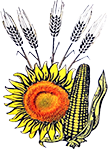New Results in Improving Resistance to Fusarium Head Blight
Indira Galit, Cristina-Mihaela Marinciu, Gabriela Şerban, Vasile Mandea, Nicolae N. Săulescu, Mariana Ittu
National Agricultural Research and Development Institute Fundulea
Keywords: wheat, scab, disease, Fusarium head blight, resistance.
Abstract: Fusarium head blight or scab, is a difficult disease to manage, as it can reduce wheat production by 30-70%. This is why progress in understanding the pathogen for improving resistance to prevent this disease is very important.
This work presents results of a study using artificial inoculations performed at NARDI Fundulea, on 13 genotypes, created by the wheat breeding team of the Fundulea Institute. The study involved injecting separately with the inoculum of Fusarium graminearum and Fusarium culmorum. The inoculum was grown on Czapek Dox culture medium kept for 7 days under black ultra violet lamps (Philips HPL-N 400 W E40) at room temperature, approximately 23°C. The artificial infection took place in the years 2020 and 2021, in the experimental field from Fundulea Institute by inserting 10 µl of inoculum into the central spikelets of 5 ears randomly selected, during flowering. Resistance assessment was done by counting the diseased spikelets after 10 and 20 frone infection. The parameters calculated to characterize this type of resistance were the severity of the disease, expressed as a percentage of Fusarium infected spikelets, and the area under the disease progression curve, the synthetic AUDPC index, for each genotype. The results were analyzed statistically by analysis of variance (ANOVA).
Results showed a statistically significant difference between the varieties and a very significant difference between the years studied. The cultivar FDL Consecvent was significantly superior to the average of all cultivars. The FDL Consecvent cultivar is being officially tested at SIVTR. This is the first time when superiority for scab resistance has been associated with productivity. This opens new prospects in creating high-yielding cultivars that are genetically protected against Fusarium head blight.
